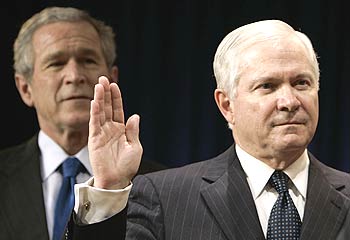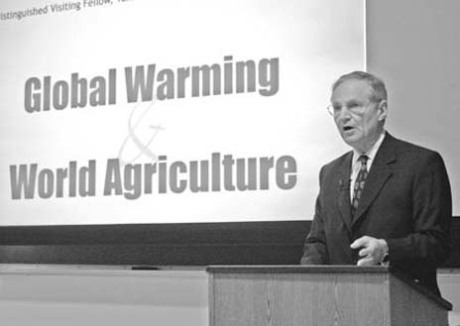
WASHINGTON, Sept. 23 — Dozens of world leaders are to gather at the United Nations on Monday for a full agenda of talks on how to fight global warming, and President Bush is skipping all the day’s events but the dinner.
Ban Ki-moon, the United Nations secretary general, is hoping to jump-start negotiations on replacing the Kyoto Protocol.
His focus instead is on his own gathering of leaders in Washington later this week, a meeting with the same stated goal, a reduction in the emissions blamed for climate change, but a fundamentally different idea of how to achieve it.
Mr. Bush’s aides say that the parallel meeting does not compete against the United Nations’ process — hijacking it, as his critics charge. They say that Mr. Bush hopes to persuade the nations that produce 90 percent of the world’s emissions to come to a consensus that would allow each, including the United States, to set its own policies rather than having limits imposed by binding international treaty.
“It’s our philosophy that each nation has the sovereign capacity to decide for itself what its own portfolio of policies should be,” said James L. Connaughton, the president’s chief environmental adviser.
Mr. Bush’s approach sets the stage for a new round of diplomatic confrontation. And it raises the prospect that he could once again put the United States in the position of objecting to any binding international agreement intended to slow or reverse the emissions linked to rising temperatures.
Whether Mr. Bush prevails remains to be seen, but the effort is the last chance in his presidency to shape the debate after years of being excoriated for keeping the United States out of the Kyoto Protocol, the international agreement that limits the emissions of greenhouse gases from most industrialized countries.
“The leadership role of the United States is absolutely essential,” said Timothy E. Wirth, a former senator and an environmental official in the Clinton administration, who is now president of the United Nations Foundation. “Unless the United States decides that it wants to be a major and committed leadership player in this and make very specific commitments, much of the rest of the world is effectively going to hide behind the skirts of the United States and not do anything.”
The growing scientific consensus that humans contribute to rising temperatures and sea levels — reflected in melting glaciers, shrinking Arctic ice and the concerns raised by former Vice President Al Gore — has pushed the issue to the top of a crowded diplomatic agenda at the opening of the United Nations General Assembly this week.
So has the expiration in 2012 of the binding restrictions under the Kyoto Protocol, which was intended to reduce participating countries’ emissions of greenhouse gases below the levels recorded in 1990.
Ban Ki-moon, the United Nations secretary general, scheduled Monday’s forum — diplomatically speaking, a “high-level event” — to jump-start talks on how to replace Kyoto, saying an agreement needed to be reached by 2009 to avoid “any vacuum” after its restrictions lapse. Negotiators are to begin those talks in December in Bali, Indonesia.
“Climate change is a challenge to our leadership, skills and vision,” Mr. Ban said at the United Nations Headquarters last week, “and we have to address that challenge boldly.”
About 80 heads of state or government are expected at the meeting, and 154 leaders and officials have signed up to speak. Secretary of State Condoleezza Rice will represent the United States, though Mr. Bush will attend a closed-door dinner on Monday night. Michael Kozak, a National Security Council official, called the event a “working-dinner format.”
Mr. Bush’s meeting in Washington this week, to be held over two days, involves 15 countries, or major economies as the White House calls them, as well as the United Nations and the European Union. The 15 countries are the major emitters of greenhouse gases.
They include the members of the group of industrialized nations, as well as other large countries with developing economies, like Indonesia, Brazil, China and India. Developing countries did not face emissions limits under Kyoto, which was one of the major reasons the United States ultimately opposed it. China, like the United States, has also gone on record as opposing mandatory caps in the future.
Mr. Bush, long skeptical of reports of human-driven climate change, proposed for the first time this year negotiating a “long-term global goal” for cutting emissions, while persuading countries to agree to invest more in research on alternative energy sources and lower trade tariffs for products that reduce emissions. While opposing a binding cap on emissions, either domestically or globally, he has supported some mandatory measures, including increases in renewable fuels like ethanol and higher fuel-efficiency standards, efforts his administration once resisted.
Briefing reporters before the week’s meetings, senior aides emphasized that each nation should decide for itself how to reduce emissions.
“The president’s central proposition is really this: Tackling global climate change requires all major economies developed and developing to work together,” said Dan Price, a deputy national security adviser. “And it requires each to make a contribution consistent with its national circumstances.”
Critics argue that the administration’s approach is not aggressive enough because it remains essentially voluntary.
“There’s no serious environmental problem that’s ever been solved by voluntary measures,” said David Doniger, climate policy director at the National Resources Defense Council.
He cited the Montreal Protocol, the 1987 agreement that required countries to ban substances blamed for depleting the earth’s ozone layer. That protocol was amended Friday, with American support, to speed up the phasing out of hydrochlorofluorocarbons used in home appliances, refrigeration equipment and air conditioners.
European leaders, including allies like Chancellor Angela Merkel of Germany, have also supported setting mandatory caps on emissions. At the Group of 8 meeting this summer, Mrs. Merkel pushed for a 50 percent reduction by 2050 but had to settle for compromise language after President Bush made it clear the United States would not agree to it.
Mr. Bush’s aides are sensitive to the accusation that the White House has ignored climate change.
They said that the administration’s embrace of voluntary measures and some mandatory steps, like requiring renewable fuels to be mixed with gasoline, was having effects that would be lasting.
Kevin Fay, executive director of the International Climate Change Partnership, a business group that supports some actions to limit emissions, said there was cautious support for Mr. Bush’s talks, though it was tempered by the administration’s previous record.
“It will take an awful lot,” Mr. Fay said, “to overcome the skepticism that has accumulated over the last six years.”
John M. Broder contributed reporting from Washington, Andrew C. Revkin from New York and James Kanter from Paris.
September 25, 2007
Categories: Conspiracy, Global Warming . . Author: thestarstrider . Comments: 1 Comment














